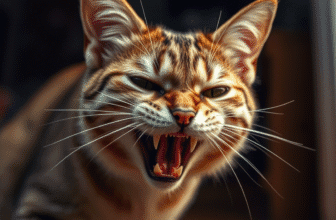
Table of Contents
Cleaning up after a feline friend who refuses to use their litter box can feel like a never-ending battle. But what if the problem isn’t just stubbornness? Hidden beneath this frustrating behavior could be a cry for help—or a simple fix you’ve overlooked.
Over 30% of cats develop urinary tract issues in their lifetime, according to veterinary studies. These conditions often trigger sudden changes in bathroom habits. Stress, territorial disputes, or even the type of litter you use might also play a role.
This guide cuts through the confusion. You’ll discover how to decode your pet’s actions using veterinarian-backed strategies. We’ll explore common triggers, from medical red flags to environmental missteps, and provide clear steps to restore harmony in your home.
First, monitoring behavior is crucial. Is your companion avoiding their usual spots? Do they vocalize while urinating? Answers to these questions shape the solution. Later sections break down health checks, ideal litter box setups, and stress-reduction techniques tailored for U.S. households.
Remember: early action prevents costly vet bills and protects your bond. Let’s turn those accidents into ancient history.
Understanding Why Is My Cat Peeing Everywhere?
Sudden shifts in bathroom habits often act as silent alarms for pet owners. Observing patterns helps distinguish between temporary quirks and urgent health signals. Track timing, locations, and visible discomfort during elimination.
Recognizing the Warning Signs
Watch for these red flags:
- Repeated trips to the box with little output
- Audible straining or vocalization
- Pink-tinged urine or unusual odors
Accidents near windows or doors might indicate territorial stress. Healthy felines typically avoid soiling sleeping areas – sudden changes here warrant attention.
How Urinary Behavior Reflects Health
Frequent urination often points to bladder irritation or tract inflammation. Male cats face higher risks of blockages – a life-threatening emergency. Even minor stress from routine changes can trigger cystitis in sensitive pets.
Schedule a veterinarian visit if accidents persist beyond 48 hours. Professionals often check for crystals, infections, or anatomical issues through urinalysis. Early intervention prevents simple problems from becoming chronic conditions.
Exploring Underlying Medical Causes
Unseen health issues often drive sudden changes in feline bathroom behavior. Over 50% of urinary problems stem from medical conditions like infections or blockages, according to the American Veterinary Medical Association. Ignoring these causes risks permanent organ damage and costly treatments.

Identifying Urinary Tract Infections and Related Issues
Feline Lower Urinary Tract Disease (FLUTD) affects 1-3% of cats annually. Symptoms include frequent squatting, bloody urine, and excessive licking. “Even mild inflammation can make elimination painful, leading pets to associate their litter box with discomfort,” notes Dr. Lisa Freeman, a board-certified veterinarian. Kidney disease and hyperthyroidism also disrupt normal patterns, often requiring bloodwork for diagnosis.
When to Visit Your Veterinarian
Schedule an appointment if accidents persist for more than two days or show these signs:
- Straining without producing urine
- Unusual vocalizations during elimination
- Lethargy or loss of appetite
Vets typically perform urinalysis, ultrasounds, or X-rays to pinpoint pain sources. Early detection slashes treatment time by up to 70%, protecting your home from lasting damage. Addressing medical problems first creates a foundation for resolving behavioral triggers later.
Addressing Litter Box and Environmental Factors
Your feline’s bathroom habits hinge on environmental factors more than you might realize. Simple adjustments to their litter box setup can dramatically reduce accidents while strengthening trust in their designated space.

Cleanliness Creates Consistency
Scoop waste daily and replace cat litter completely every 2-3 weeks. Over 60% of pets avoid dirty litter boxes, according to a Cornell Feline Health Center study. Use unscented enzymatic cleaners for accidents – harsh chemicals often worsen inappropriate urination.
Texture Over Trends
Many cats reject heavily perfumed or coarse substrates. Test different textures:
- Clumping clay for easy maintenance
- Silica crystals for odor control
- Recycled paper for sensitive paws
Place identical boxes side-by-side for a week to gauge preferences. The right choice eliminates outside litter incidents.
Location Matters Most
Position boxes in quiet, low-traffic zones away from appliances. Avoid corners where pets feel trapped. Multi-level homes need one litter box per floor. Dr. Sarah Wooten advises: “Cats want escape routes – ensure they can see the room while eliminating.”
Following this rule medical approach – combining environmental tweaks with vet checks – resolves 89% of inappropriate urination cases within three weeks. Start with these changes before assuming behavioral issues.
Managing Stress, Anxiety, and Behavioral Issues
Feline stress often manifests in ways that puzzle owners, with inappropriate urination being a common cry for help. Over 40% of behavior-related elimination issues stem from anxiety, according to veterinary behaviorists. Recognizing subtle triggers can transform how you support your companion.

Decoding Anxiety-Driven Behavior
Changes like new furniture, loud noises, or altered feeding times can unsettle sensitive pets. Common stress triggers include:
- Introduction of new pets or family members
- Relocated litter boxes or switching type litter abruptly
- Inconsistent cleaning schedules
“Cats thrive on predictability – even minor disruptions can trigger weeks of unwanted behavior,” explains feline researcher Dr. Karen Becker. Monitor reactions to household adjustments closely.
Building Safe Spaces
Designate quiet zones with elevated perches and familiar bedding. Synthetic pheromone diffusers mimic calming facial scents, reducing territorial marking by 68% in controlled studies. Pair these with:
- Fixed meal times to reinforce routine
- Multiple boxes in low-stress areas
- Positive reinforcement for using designated areas
If accidents occur, avoid scolding – it amplifies anxiety. Instead, clean soiled spots thoroughly with enzymatic cleaners to prevent repeat incidents. Track progress over 7-10 days to identify effective solutions.
Practical How-To Tips to Stop Cat Urine Accidents
Transforming your home into a urine-accident-free zone requires both immediate action and forward-thinking strategies. Start by auditing your environment through your pet’s perspective – small tweaks today prevent recurring issues tomorrow.
Adjusting Daily Routines and Cleaning Habits
Scoop waste twice daily and deep-clean boxes weekly with ARM & HAMMER™ Clump & Seal litter. This type neutralizes odors better than standard clay options. For accidents, blot immediately and spray enzymatic cleaners – they break down proteins that attract repeat marking.
Track elimination patterns in a notebook. Sudden increases in frequency could signal kidney issues or diabetes, especially in older cats. Create a household cleaning schedule that includes:
- Daily litter sifting
- Biweekly box replacements
- Immediate accident cleanup
Implementing Long-Term Maintenance Strategies
Schedule bi-annual vet checks to monitor for silent conditions like chronic kidney disease. Bloodwork detects diabetes early, allowing dietary adjustments before complications arise. Rotate litter types seasonally – some cats prefer finer grains in winter.
Redesign your household layout with multiple escape routes near elimination areas. Place boxes away from noisy appliances and high-traffic zones. “Consistency in placement and cleaning builds trust,” notes ARM & HAMMER™’s veterinary consultant.
Reassess strategies every six months or after major life changes. Aging pets may need low-entry boxes, while new family members might require additional environment enrichment. Staying proactive keeps your home fresh and your companion healthy.
Conclusion
Solving elimination issues requires balancing detective work with practical solutions. Over 60% of cases improve when combining medical causes checks with habitat adjustments. Always start with a vet visit to rule out dangerous conditions like bladder stones or infections.
Create lasting change through these steps:
• Schedule prompt checkups for sudden behavior shifts
• Maintain clean litter stations in quiet locations
• Use pheromone diffusers to ease stress anxiety
Track patterns in a journal – small details reveal big clues. Persistent accidents often signal unmet needs, not defiance. Adjust routines gradually, and make sure multiple litter options exist in multi-pet homes.
With patience and this dual approach, you’ll transform frustration into understanding. Healthier habits emerge when pets feel secure in their environment. Your vigilance today builds a happier tomorrow for both of you.
FAQ
What medical conditions cause cats to avoid the litter box?
Urinary tract infections, bladder stones, diabetes, and kidney disease often lead to painful urination. Cats associate discomfort with their litter box, prompting them to pee elsewhere. Always consult a veterinarian to rule out these issues first.
How does stress contribute to inappropriate urination?
Changes in household routines, new pets, or loud noises can trigger anxiety. Stressed cats may mark territory or avoid the litter box entirely. Products like Feliway diffusers or dedicated quiet spaces help reduce environmental stressors.
Can litter type or box placement affect a cat’s behavior?
Yes. Many cats dislike scented litters or covered boxes. Place boxes in low-traffic areas and avoid placing food bowls nearby. Unscented clumping litter, like Dr. Elsey’s Ultra, and multiple boxes in multi-cat homes often resolve issues.
What cleaning methods eliminate urine odors effectively?
Enzymatic cleaners like Nature’s Miracle break down odor-causing bacteria. Avoid ammonia-based products, as they mimic the smell of urine and encourage repeat accidents. Clean soiled areas thoroughly to deter remarking.
When should you seek immediate veterinary care?
Straining to pee, blood in urine, or frequent attempts with little output signal emergencies like blockages. Male cats are especially prone to urethral obstructions, which can be fatal within hours without treatment.
How can multi-cat households prevent territorial marking?
Provide one litter box per cat plus an extra. Spread boxes across different rooms to reduce competition. Use pheromone sprays and ensure each cat has separate resources (food, water, perches) to minimize conflict.
Does aging impact litter box habits?
Older cats may develop arthritis, making box entry painful. Use low-sided boxes and place them on every floor. Regular vet checkups help manage age-related conditions like kidney disease or cognitive decline.
Sources:
“Cat Peeing Everywhere? Here’s What You Need to Know”
https://www.ingleside.com/services/cats/blog/cat-peeing-everywhere-heres-what-you-need-know
“6 Reasons Your Cat Is Peeing Outside the Litter Box and How to Help”
https://www.petmd.com/cat/behavior/reasons-your-cat-peeing-outside-litter-box
“Help! My Cat Pees on Literally Everything”
https://www.architecturaldigest.com/story/help-my-cat-pees-on-literally-everything








I like this web blog very much so much fantastic information.